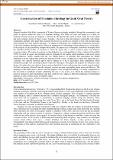Construction of Feminine Ideology in Gusii Oral Poetry

View/
Publication Date
2019Author
Nyambane Fredrick Monanti Prof Kitche Magak, Jane Bwonya
Metadata
Show full item recordAbstract/
Abagusii females of the Kisii community of Western Kenya are largely socialized through the community’s oral poetry to operate within the limits of a feminine ideology. The choice of Gusii oral poetry as a vehicle for studying feminine ideology of Abagusii is informed by the fact that this genre of Gusii verbal arts is the oldest and most versatile genres of Gusii orature. Equally, it has had a long and intimate relationship with human communities globally. This paper thus examines the Gusii oral poems as a semiotic system with encoded signs which embody the Gusii feminine ideology. The objective of the paper is to establish the construction and nature of the Gusii feminine ideology and its efficacy in shaping social relationships within Abagusii as a social entity. In the analysis of the purposively sampled oral poems, this paper uses a conceptual framework developed from the Chandler (1995) strands of semiotics in which he argues that a culture produces signs and attributes meanings to them. The tenets of semiosis are then linked to the sociological literary theory strands of Rosenblatt (1978) in which he argues that literature mirrors protocols of the society which produces it and serves given social purposes. Finally, strands from the two literary theories of semiotics and sociological are further interlinked with the Althusserian (1989) and Eagleton (1976)’s tenets of Marxism in which they argue that art is a product of a specific historical epoch and its purpose is to be an Ideological State Apparatuses which interpellates people into becoming subjects of specific ideologies. This paper has adopted the analytical study design. Secondary data was obtained from a review of published works and primary data was the textual analysis of Gusii oral poems collected from the Abagusii resource persons, copyrighted music stores and libraries. The sampling of data and resource persons was both purposive and through snowballing. The study is significant in the sense that it contributes towards celebrating the role of oral poetry as a vehicle for enabling humans to perceive themselves, their environment and their world in ways unique to them and enhancing of intercultural relations as well as forms a basis for related studies. Abagusii females of the Kisii community of Western Kenya are largely socialized through the community’s oral poetry to operate within the limits of a feminine ideology. The choice of Gusii oral poetry as a vehicle for studying feminine ideology of Abagusii is informed by the fact that this genre of Gusii verbal arts is the oldest and most versatile genres of Gusii orature. Equally, it has had a long and intimate relationship with human communities globally. This paper thus examines the Gusii oral poems as a semiotic system with encoded signs which embody the Gusii feminine ideology. The objective of the paper is to establish the construction and nature of the Gusii feminine ideology and its efficacy in shaping social relationships within Abagusii as a social entity. In the analysis of the purposively sampled oral poems, this paper uses a conceptual framework developed from the Chandler (1995) strands of semiotics in which he argues that a culture produces signs and attributes meanings to them. The tenets of semiosis are then linked to the sociological literary theory strands of Rosenblatt (1978) in which he argues that literature mirrors protocols of the society which produces it and serves given social purposes. Finally, strands from the two literary theories of semiotics and sociological are further interlinked with the Althusserian (1989) and Eagleton (1976)’s tenets of Marxism in which they argue that art is a product of a specific historical epoch and its purpose is to be an Ideological State Apparatuses which interpellates people into becoming subjects of specific ideologies. This paper has adopted the analytical study design. Secondary data was obtained from a review of published works and primary data was the textual analysis of Gusii oral poems collected from the Abagusii resource persons, copyrighted music stores and libraries. The sampling of data and resource persons was both purposive and through snowballing. The study is significant in the sense that it contributes towards celebrating the role of oral poetry as a vehicle for enabling humans to perceive themselves, their environment and their world in ways unique to them and enhancing of intercultural relations as well as forms a basis for related studies.
